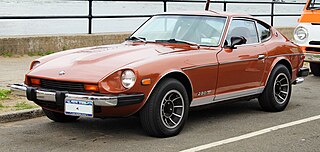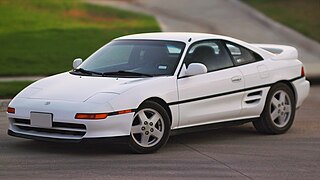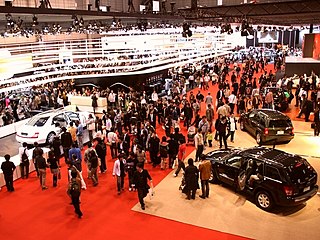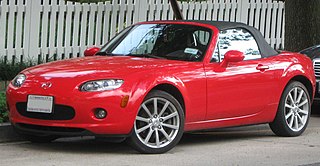
The Mazda MX-5 is a lightweight two-passenger roadster sports car manufactured and marketed by Mazda with a front mid-engine, rear-wheel-drive layout. The convertible is marketed as the Mazda Roadster or Eunos Roadster in Japan, and as the Mazda MX-5 Miata in North America, where it is widely known as the Miata.

The Nissan Z-series is a model series of sports cars manufactured by Nissan, in seven generations since 1969.

A sports car is a car designed with an emphasis on dynamic performance, such as handling, acceleration, top speed, the thrill of driving and racing capability. Sports cars originated in Europe in the early 1900s and are currently produced by many manufacturers around the world.

Lotus Cars Limited is a British automotive company headquartered in Norfolk, England. It manufactures sports cars and racing cars noted for their light weight and fine handling characteristics.

Nissan Motorsports International, abbreviated as Nismo, is a division of Nissan Motorsports & Customizing focused in motorsport and performance-oriented car models for Nissan. Nismo was initially a company, Nissan Motorsports International Co., Ltd., formed in 1984 as a result of a merger of two motorsport departments, being the in-house tuning, motorsports and performance subsidiary of Nissan. It has competed in JSPC, JTCC, the 24 Hours of Le Mans and the 24 Hours of Daytona. They currently participate in Super GT, GT Racing and Formula E. Nismo ceased to be a company in April 2022 by being merged with sister Autech into a new Nissan subsidiary, Nissan Motorsport & Customizing.

The Toyota MR2 is a line of two-seat, mid-engined, rear-wheel-drive sports cars manufactured in Japan and marketed globally by Toyota from 1984 until 2007 over three generations: W10 (1984–1989), W20 (1989–1999) and W30 (2000–2007). It is Japan's first rear mid-engined production car.

The Nissan 350Z is a two-door, two-seater sports car that was manufactured by Nissan Motor Corporation from 2002 until 2009 and marks the fifth generation of Nissan's Z-car line. The 350Z entered production in 2002 and was sold and marketed as a 2003 model from August 2002. The first year there was only a coupe, as the roadster did not debut until the following year. Initially, the coupe came in Base, Enthusiast, Performance, Touring and Track versions, while the Roadster was limited to Enthusiast and Touring trim levels. The Track trim came with lightweight wheels and Brembo brakes, but its suspension tuning was the same as all other coupes. The Nissan 350Z was succeeded by the 370Z for the 2009 model year.

In automotive engineering a multi-valve or multivalve engine is one where each cylinder has more than two valves. A multi-valve engine has better breathing and may be able to operate at higher revolutions per minute (RPM) than a two-valve engine, delivering more power.

The Datsun Sports, was a series of roadsters produced by Nissan in the 1960s. The series was a predecessor to the Z-car in the Fairlady line, and offered a competitor to the European MG, Triumph, Fiat and Alfa Romeo sports cars. Beginning with the 1959 S211, the line was built in two generations: the first generation was largely handbuilt in small numbers, while the second generation was series produced. The second generation first appeared in 1961 and continued through 1970 with the SP311 and SR311 lines.

The Isuzu Piazza is a small, sporty 3-door liftback coupé which was manufactured by Isuzu from 1981 until 1992 in two generations. The Isuzu Piazza was marketed as the Isuzu Impulse in North America and as the Holden Piazza in Australia.

The Nissan Tiida is a compact car produced by the Japanese manufacturer Nissan since 2004 through three generations. Depending on the market, the Tiida was also marketed as a subcompact car, particularly in the Americas for the first-generation model as the Nissan Versa. The first-generation model (C11) was produced up to 2018 in some markets, and was offered as a four-door sedan and a five-door hatchback.

The Tokyo Motor Show (東京モーターショー) is a biennial auto show held in October–November at the Tokyo Big Sight, Tokyo, Japan for cars, motorcycles and commercial vehicles. Hosted by the Japan Automobile Manufacturers Association (JAMA), it is a recognized international show by the Organisation Internationale des Constructeurs d'Automobiles, and normally sees more concept cars than actual production car introductions which is the reason why the auto press see the show as one of the motorshow's big five.

The Nissan Rasheen is a compact crossover SUV with four-wheel drive capabilities produced from November 1994 to August 2000 by Nissan. A prototype was first shown at the October 1993 Tokyo Auto show. It was offered with three different inline-four engines: from the original 1.5-liter GA15DE, to a larger 1.8-liter SR18DE, and finally a 2.0-liter SR20DE in the Rasheen Forza. The car has five seats and a rugged, quirky and angularly styled body. It is a very small and short four-wheel drive that is often compared to Eastern European cars in design, particularly the Wartburg 353, but is also reminiscent of Nissan's "Pike" cars. As for the Be-1 and Figaro, Rasheen production was carried out by contract manufacturer Takada Kogyo. It was exclusive to Nissan Japanese dealership network called Nissan Red Stage.
The Vision Gran Turismo program is a series of fictional concept cars for the Gran Turismo video game series, developed by a cross-section of the world's top automobile manufacturers. These vehicles appeared originally in the video games Gran Turismo 6, Gran Turismo Sport, and later in Gran Turismo 7, all from Polyphony Digital. For the most part, they apply present-day technology and materials, with two notable exceptions that utilize novel propulsion and aerodynamic technologies. Their appearance as free in-game cars has been staggered since the launch of GT6 in 2013, with each one being available for download upon release.

The Lexus F marque is the high-performance division of cars produced by Lexus. The F is short for flagship and Fuji Speedway, the chief test site of Lexus performance vehicle development in Oyama, Suntō District, Shizuoka Prefecture, Japan.
The MID4 was an experimental sports car produced by Nissan.

The Infiniti Q50 is a compact executive car manufactured by Nissan for its luxury brand, Infiniti. Replacing the G/Q40 sedan, it debuted at the 2013 North American International Auto Show and went on sale in North America in the third quarter 2013 and in Europe in fourth quarter 2013. It is the export model of the Japanese domestic market's V37 Nissan Skyline.

The Honda S660 is a two-seat targa sports car in the kei class manufactured by the Japanese manufacturer Honda with a transverse mid-engine and rear-wheel-drive layout. It is the successor to the Honda Beat, and the Honda S2000.

The Mazda MX-5 (NC) is the third generation of the Mazda MX-5 manufactured from 2005 to 2015. At its introduction in 2005, it won the Car of the Year Japan Award and made Car and Driver's 10Best list from 2006 to 2013. The NC is the first MX-5 generation to feature a retractable hardtop variant, with its roof being able to fold and unfold in 12 seconds without sacrificing trunk space.

The Nissan Z, known in Japan as the Nissan Fairlady Z, is the seventh generation of the Z-car line of sports cars manufactured by Nissan. The model succeeded the 370Z, though is built on a modified and revised version of the previous generation's platform. The model also drops the numerical nomenclature of the previous generations.


















